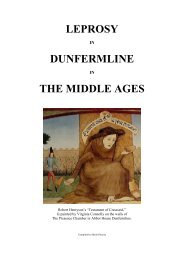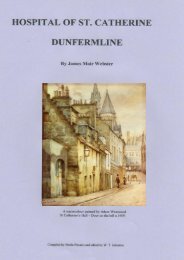PASSAGIUM REGINAE The - Royal Dunfermline
PASSAGIUM REGINAE The - Royal Dunfermline
PASSAGIUM REGINAE The - Royal Dunfermline
You also want an ePaper? Increase the reach of your titles
YUMPU automatically turns print PDFs into web optimized ePapers that Google loves.
<strong>The</strong> name Pitfirrane is derived from the Gaelic pit a hollow and fearan, land<br />
the hollow of the land. <strong>The</strong> house stands in a spacious park full of very fine<br />
trees, including sycamores, elms, beeches, horse-chestnuts, and limes, some of<br />
them of considerable age. <strong>The</strong>re is one tree in particular, standing on the west<br />
side of the house, a gigantic lime, remarkable for its spread, which is formed<br />
by seven lower boughs that sweep downwards and fan out into smaller<br />
branches until they make almost an unbroken circle. Having touched the<br />
ground they curl up again in manner of horse-chestnuts, and at the points of<br />
contact some of the branches throw up vertical shoots ten and twelve feet high.<br />
Eight feet from the ground the bole of the tree is enormous. A portrait of this<br />
giant and its measurements, have been published in <strong>The</strong> Scottish Field. As<br />
recorded on the tree itself, they are; height, 78 ft.; girth 18 ft.; spread 298 ft.<br />
<strong>The</strong> house dates back to a very remote antiquity, the earliest portion having<br />
been built in the eleventh century. Considerable additions were made in the<br />
fifteenth century. <strong>The</strong> walls ae in many places eight to ten feet thick contain<br />
several secret passages. One of these is reached by a „secret‟ door at the foot<br />
of the fine stone spiral staircase which leads to the drawing-room. It too has a<br />
staircase, very narrow, and long since closed up, with a secret exit that is now,<br />
and probably always was, high up on the south wall of the room which the late<br />
Sir Arthur Halkett used as his study. This comparatively large stone-vaulted<br />
chamber, all plastered over, was probably once a pen into which cattle were<br />
driven during a Highland raid; for many country houses of this size 500 years<br />
ago had such places for the shelter and protection of cattle at night. An<br />
enormous malleable-iron gate of the ancient prison type, hanging now between<br />
two stone pillars near the garden, and which was found some years ago lying<br />
derelict, is supposed to have been the gate of the pen, and the „secret‟ door<br />
high up in the wall would be the one through which the family could enter the<br />
house by means of a ladder.<br />
<strong>The</strong>re are many works of art at Pitfirrane, and the history of the Halketts may<br />
be traced far back on its walls. An early link in its lengthy chain of notable<br />
events, and one of the most interesting, is, however, not a picture, but a stirrupcup,<br />
which stands in the corridor close to the front door – a tall dusky claretcoloured<br />
wine-glass with a colourless glass stem of elaborate and fanciful<br />
design. It is of the type known as FlÛgel-glăss (winged glass), made in Italy in<br />
the sixteenth, century and later in Germany and Holland. Inside the stem runs<br />
a scarlet thread which saith tradition quivered if there was poison in the wine.<br />
From this cup James VI, quaffed a few mouthfuls of sack just before he left<br />
<strong>Dunfermline</strong> Palace for England. It was taken back that very night by Sir<br />
Robert Halkett to Pitfirrane, and there it has remained ever since. <strong>The</strong><br />
attractive bit of glass-work now stands in a large canopied case, designed and<br />
built by the late Sir Noel Paton, R.S.A., out of oak from the old Abbey Church<br />
at <strong>Dunfermline</strong>. On the floor of the case beside the cup is a gold ring, which<br />
46




